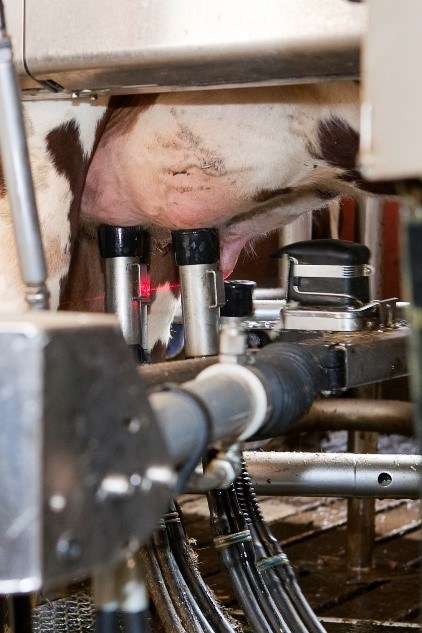Along with increased milk production a decline in dairy cow fertility was seen in the 90ies and in the beginning of this century, especially in Holsteins. For this reason it has been a strong interest in selection to improve fertility. In this PhD project Amabel demonstrated that “novel” endocrine fertility traits derived from in-line milk progesterone concentrations are more heritable than classical fertility traits. Moreover, it was shown that in-line milk progesterone combined with genomics is the best way to improve the underlying physiological traits for fertility in dairy cows. However, for an economic breeding goal the classical measures are effective since these are recorded on a much larger scale.
Improved reproductive performance has a substantial effect on the longevity of cow and overall profitability of dairy cattle farming. Unfortunately, the low heritability of classical fertility traits derived from calving and insemination data makes genetic improvement by traditional animal breeding slowly. Therefore, there is an interest in finding measures of fertility that have a higher heritability or using genomic information to aid genetic selection for fertility. Endocrine fertility traits based on progesterone concentration records in milk have been widely accepted as valid indicators for fertility because they and are not biased by farm management decision and more directly reflect a cows’ reproductive physiology than classical fertility traits. However, the use of endocrine traits in routine genetic evaluations has been constrained by the high cost associated with collecting progesterone records on sufficient number of animals. Nonetheless, in-line technology like the Herd Navigator now exists to automatically measure progesterone concentration during milking, enabling sampling of more animals at reasonable cost.
In this thesis, the use of milk progesterone concentrations and genomic information was explored to improve genetic selection for fertility in dairy cattle using in-line milk progesterone records. Several endocrine traits were heritable, and showed a reasonable repeatability. The Genome-wide association study identified 17 regions associated with endocrine fertility traits, Fine-mapping target regions for the endocrine traits on BTA 2, and 3 confirmed the QTL from the genome-wide association study, and identified several associated variants that can contribute to an index of markers for genetic improvement of fertility. Several potential candidate genes underlying endocrine fertility traits were also identified in the target regions.
The potential of different phenotyping strategies to improve accuracy of genomic prediction for fertility with endocrine fertility traits was investigated. The accuracy of genomic prediction, was substantially improved when endocrine and classical fertility traits were combined in multi-trait genomic prediction. The results showed that for prediction of fertility, there is no benefit of investing in a cow reference population when the breeding goal is based on classical fertility traits. However, when considering a more biological breeding goal for fertility like C-LA, accuracy is substantially improved when endocrine traits are available from a limited number of farms. Evaluation of the potential accuracy of across country genomic prediction showed that when the training population from one country (e.g., Sweden) is small, substantial increase in accuracy can be achieved by adding animals from another country (e.g., Netherlands), however, the accuracy was highly dependent on the genetic correlation between countries. Recording strategies that optimally use the Herd Navigator of for genomic prediction, in terms of, the number of farms, and recording period for endocrine traits were investigated. The results showed that for genomic prediction of fertility using C-LA, it is more important to have more animals with C-LA records than more C-LA records per animal. Moreover it was recommended to establish phenotyping labs where animals are phenotyped in batches to collect as many phenotypes as possible on expensive novel traits for genomic prediction.
